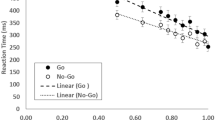Abstract
The Sustained Attention to Response Task (SART) is a Go-No-Go signal detection task developed to measure lapses of attention. In this study, we examined the impact that warning signals, reliable and unreliable, have on SART performance. Eighteen participants performed a no-warning, reliable-warning, or unreliable-warning SART. Response times were faster, errors of commission lower, but errors of omission higher in the reliable-warning SART in comparison with the no-warning or unreliable-warning SART. There was a significant negative correlation between participants’ errors of commission rate and their response times in the unreliable-warning and no-warning SART. This correlation was reduced in the reliable-warning SART. Making the task perceptually easier reduces the errors of commission, in contradiction to the mindlessness perspective, and reduces the speed-accuracy trade-off. These results, overall, support the view that the SART is primarily a measure of response strategy, not sustained attention per se.





Similar content being viewed by others
References
Aiken EG, Lau AW (1967) Response prompting and response confirmation: a review of recent literature. Psychol Bull 68:330–341
Annett K, Patterson L (1967) Training for auditory detection. Acta Psychol 27:420–426
Chan RCK (2001) A further study on the sustained attention response to task (SART): the effect of age, gender and education. Brain Inj 15:819–829
Chan RCK (2002) Attentional deficits in patients with persisting postconcussive complaints: a general deficit or specific component deficit? J Clin Exp Neuropsyc 24:1081–1093
Cheyne JA, Carriere JSA, Smilek D (2006) Absent-mindedness: lapses of conscious awareness and everyday cognitive failures. Conscious Cogn 15:578–592
Cheyne JA, Carriere JSA, Smilek D (2009a) Absent minds and absent agents: attention-lapse induced alienation of agency. Conscious Cogn 18:481–493
Cheyne JA, Solman GJF, Carriere JSA, Smilek D (2009b) Anatomy of an error: a biderectional state model of task engagement/disengagement and attention-related errors. Cognition 111:98–113
Davies DR, Parasuraman R (1982) The psychology of vigilance. Academic Press, London
Dockree PM, Kelly SP, Roche RA, Hogan MJ, Reilly RB, Robertson IH (2004) Behavioural and physiological impairments of sustained attention after traumatic brain injury. Cogn Brain Res 20:403–414
Dockree PM, Bellgrove MA, O’Keefe FM, Moloney P, Aimola L, Cartoon S, Robertson IH (2006) Sustained attention in traumatic brain injury (tbi) and healthy controls: enhanced sensitivity with dual-task load. Exp Brain Res 168:218–229
Giambra LM (1995) A laboratory based method for investigating influences on switching attention to task unrelated imagery and thought. Conscious Cogn 4:1–21
Greene CM, Bellgrove MA, Gill M, Robertson IH (2009) Noradrenergic genotype predicts lapses in sustained attention. Neuropsychologia 47:591–594
Grier RA, Warm JS, Dember WN, Matthews G, Galinsky TL, Szalma JL, Parasuraman R (2003) The vigilance decrement reflects limitations in effortful attention not mindlessness. Hum Factors 45:349–359
Helton WS (2009) Impulsive responding and the sustained attention to response task. J Clin Exp Neuropsyc 31:39–47
Helton WS, Warm JS (2008) Signal salience and the mindlessness theory of vigilance. Acta Psychol 129:18–25
Helton WS, Dember WN, Warms JS, Matthews G (2000) Optimism, pessimism, and false failure feedback: effects on vigilance performance. Curr Psychol 18:311–325
Helton WS, Hollander TD, Warm JS, Matthews G, Dember WN, Wallart M, Beauchamp G, Parasuraman R, Hancock PA (2005) Signal regularity and the mindlessness model of vigilance. Brit J Psychol 96:249–261
Helton WS, Kern RP, Walker DR (2009) Conscious thought and the sustained attention to response task. Conscious Cogn 18:600–607
Helton WS, Weil L, Middlemiss A, Sawers A (2010) Global interference and spatial uncertainty in the sustained attention to response task (SART). Conscious Cogn 19:77–85
Hitchcock EM, Dember WN, Warm JS, Maroney BW, See J (1999) Effects of cueing and knowledge of results on workload and boredom in sustained attention. Hum Factors 41:365–372
Johnson KA, Kelly SP, Bellgrove MA, Barry E, Cox M, Gill M, Robertson IH (2007) Response variability in attention deficiet hyperactivity disorder: evidence for neuropsychological heterogeniety. Neuropsychologia 45:630–638
Mackworth NH (1948) The breakdown of vigilance during prolonged visual search. Q J Exp Psychol 1:6–21
Mackworth NH (1950) Researches on the measurement of human performance. Medical Research Council Special Report, No. 2680. London: H.M.S.O. (Reprinted from Selected papers in the design and use of control systems pp 174–331 by HW Sinaiko Ed., 1961, New York: Dover)
Manly T, Robertson IH, Galloway M, Hawkins K (1999) The absent mind: Further investigations of sustained attention to response. Neuropsychologia 37:661–670
Manly T, Heutlink J, Davidson B, Gaynord B, Greenfield E, Parr A, Ridgeway V, Robertson IH (2004) An electronic knot in the hankerchief: content free cueing and the maintenance of attentive control. Neuropsychol Rehabil 14:89–116
Matthews G, Davies DR, Westerman SJ, Stammers RB (2000) Human performance: cognition. Psychology Press, stress and individual differences. East Sussex, UK
O’Connell RG, Bellgrove MA, Dockree PM, Robertson IA (2006) Cognitive remediation in ADHD: effects of periodic non-contingent alerts on sustained attention to response. Neuropsychol Rehabil 16:653–665
Peebles D, Bothell D (2004) Modelling performance in the sustained attention to response task. In proceedings of the sixth international conference on cognitive modeling, Pittsburgh, PA: Carnegie Mellon University/University of Pittsburgh pp 231–236
Robertson IH, Manly T, Andrade J, Baddeley BT, Yiend J (1997) “Oops!”: performance correlates of everyday attentional failures in traumatic brain injured and normal subjects. Neuropsychologia 35:747–758
See JE, Howe SR, Warm JS, Dember WN (1995) A meta-analysis of the sensitivity decrement in vigilance. Psychol Bull 117:230–249
Smallwood J, Baracaia SF, Lowe M, Obonsawin MC (2003) Task-unrelated-thought whilst encoding information. Conscious Cogn 12:452–484
Smallwood J, Davies JB, Heim D, Finnigan F, Sudberry M, O’Conner R, Obonsawin M (2004) Subjective experience and the attentional lapse: task engagement and disengagement during sustained attention. Conscious Cogn 13:657–690
Temple JG, Warm JS, Dember WN, Jones KS, LaGrange CM, Matthews G (2000) The effects of signal salience and caffeine on performance, workload and stress in an abbreviated vigilance task. Hum Factors 42:183–194
Turatto M, Galfano G (2000) Color, form and luminance capture attention in visual search. Vision Res 40:1639–1643
Warm JS (1984) An introduction to vigilance. In: Warm JS (ed) Sustained attention in human performance. Wiley, Chichester, UK, pp 1–14
Warm JS (1993) Vigilance and target detection. In: Huey BM, Wickens CD (eds) Workload transitions: implications for individual and team performance. National Academy Press, Washington, DC, pp 139–170
Warm JS, Parasuraman R, Matthews G (2008) Vigilance requires hard mental work and is stressful. Hum Factors 50:433–441
Weiner EL, Attwood DA (1968) Training for vigilance: combined cueing and knowledge of results. J Appl Psychol 52:474–479
Weissman DH, Roberts KC, Visscher KM, Woldorff MG (2004) The neural bases of momentary lapses of attention. Nat Neurosci 9:971–978
Author information
Authors and Affiliations
Corresponding author
Rights and permissions
About this article
Cite this article
Helton, W.S., Head, J. & Russell, P.N. Reliable- and unreliable-warning cues in the Sustained Attention to Response Task. Exp Brain Res 209, 401–407 (2011). https://doi.org/10.1007/s00221-011-2563-9
Received:
Accepted:
Published:
Issue Date:
DOI: https://doi.org/10.1007/s00221-011-2563-9




